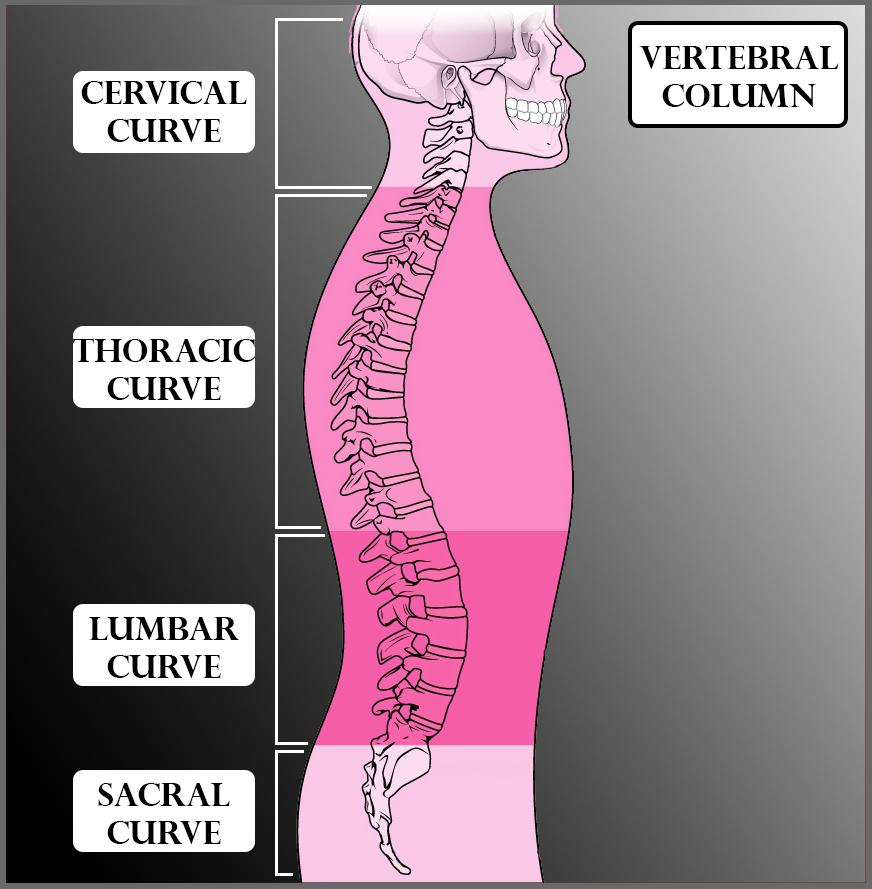
Number of cervical vertebrae in a human being is:
(a) 7
(b) 9
(c) 12
(d) 6
Answer
495.6k+ views
1 likes
Hint: In almost all mammals including humans the top row of the vertebrae in the neck region of the vertebral column constitute the cervical vertebrae. Giraffes, despite having a long neck, have the same number of cervical vertebrae as human beings.
Complete answer:
In almost all the mammals including human beings, the first seven vertebrae of the vertebral column constitute the cervical vertebrae. These are small-sized and present in the neck region.
The characteristics of the cervical vertebrae are:
-They are small and oval-shaped
-These have a relatively wide vertebral arch
-The cervical vertebrae have relatively long, bifid spinous processes except for the C7 vertebra.
Additional Information: The vertebral column, also known as the backbone lies in the mid-dorsal region of the neck and trunk and is made up of 26 units called vertebrae.
Between two adjacent vertebrae, a disc or pad of fibrous cartilage is present which provides flexibility to the vertebral column. These discs or pads are called the intervertebral discs.
A hollow central portion occurs in each vertebra through which the spinal cord passes.
The types of vertebrae are:
-Cervical vertebrae-7
-Thoracic vertebrae-12
-Lumbar vertebrae-5
-Sacral Vertebrae-1
-Coccyx vertebrae-1
The first vertebra is known as the atlas and the second is known as the axis.
The atlas supports the head and consists of a complete ring of bone. On its upper surface, it articulates with the condyles of the occipital bone, forming a condyloid atlanto-occipital joint, at which the nodding movements of the head take place.
The axis is the pivot on which the atlas turns. From the body of the axis, a bony process called the odontoid peg arises which articulates with the back of the anterior arch of the atlas. The lateral masses of the atlas articulate with corresponding facets on the axis, forming a pivot joint at which the head rotates.
The seventh cervical vertebra is the only cervical vertebra that does not have a bifid spinous process.
So, the correct answer is, “7”.
Note: -1, 2, 7 cervical vertebrae are atypical whereas 3 to 6 vertebrae are typical.
-The transverse processes are perforated by foramen transversarium for the passage of the vertebral arteries except in 7 vertebrae.
-In the embryonic stage, sacral vertebrae are 5 in number and coccygeal vertebrae are 4 in number which later fuses in adults to form 1 and 1 respectively.
-Coccygeal vertebrae together form coccyx which is a small vestigial tail bone.

Complete answer:
In almost all the mammals including human beings, the first seven vertebrae of the vertebral column constitute the cervical vertebrae. These are small-sized and present in the neck region.
The characteristics of the cervical vertebrae are:
-They are small and oval-shaped
-These have a relatively wide vertebral arch
-The cervical vertebrae have relatively long, bifid spinous processes except for the C7 vertebra.
Additional Information: The vertebral column, also known as the backbone lies in the mid-dorsal region of the neck and trunk and is made up of 26 units called vertebrae.
Between two adjacent vertebrae, a disc or pad of fibrous cartilage is present which provides flexibility to the vertebral column. These discs or pads are called the intervertebral discs.
A hollow central portion occurs in each vertebra through which the spinal cord passes.
The types of vertebrae are:
-Cervical vertebrae-7
-Thoracic vertebrae-12
-Lumbar vertebrae-5
-Sacral Vertebrae-1
-Coccyx vertebrae-1
The first vertebra is known as the atlas and the second is known as the axis.
The atlas supports the head and consists of a complete ring of bone. On its upper surface, it articulates with the condyles of the occipital bone, forming a condyloid atlanto-occipital joint, at which the nodding movements of the head take place.
The axis is the pivot on which the atlas turns. From the body of the axis, a bony process called the odontoid peg arises which articulates with the back of the anterior arch of the atlas. The lateral masses of the atlas articulate with corresponding facets on the axis, forming a pivot joint at which the head rotates.
The seventh cervical vertebra is the only cervical vertebra that does not have a bifid spinous process.
So, the correct answer is, “7”.
Note: -1, 2, 7 cervical vertebrae are atypical whereas 3 to 6 vertebrae are typical.
-The transverse processes are perforated by foramen transversarium for the passage of the vertebral arteries except in 7 vertebrae.
-In the embryonic stage, sacral vertebrae are 5 in number and coccygeal vertebrae are 4 in number which later fuses in adults to form 1 and 1 respectively.
-Coccygeal vertebrae together form coccyx which is a small vestigial tail bone.

Recently Updated Pages
Master Class 9 General Knowledge: Engaging Questions & Answers for Success

Master Class 9 English: Engaging Questions & Answers for Success

Master Class 9 Science: Engaging Questions & Answers for Success

Master Class 9 Social Science: Engaging Questions & Answers for Success

Master Class 9 Maths: Engaging Questions & Answers for Success

Class 9 Question and Answer - Your Ultimate Solutions Guide

Trending doubts
State and prove Bernoullis theorem class 11 physics CBSE

Who built the Grand Trunk Road AChandragupta Maurya class 11 social science CBSE

1 ton equals to A 100 kg B 1000 kg C 10 kg D 10000 class 11 physics CBSE

State the laws of reflection of light

One Metric ton is equal to kg A 10000 B 1000 C 100 class 11 physics CBSE

Difference Between Prokaryotic Cells and Eukaryotic Cells




